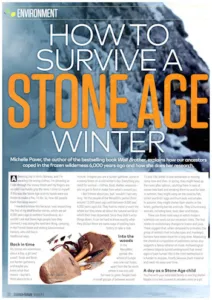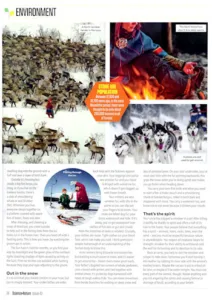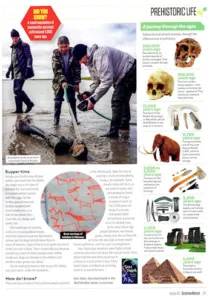How To Survive A Stone-Age Winter
 A freezing day in Arctic Norway, and I’m wearing the wrong clothes. I’m shivering as I ride through the snowy forest and my fingers are so cold I can hardly grip the reins. I think to myself: If this was the Stone Age and my hands were too frozen to make a fire, I’d die. So, how did people back then keep warm?
A freezing day in Arctic Norway, and I’m wearing the wrong clothes. I’m shivering as I ride through the snowy forest and my fingers are so cold I can hardly grip the reins. I think to myself: If this was the Stone Age and my hands were too frozen to make a fire, I’d die. So, how did people back then keep warm?
I needed to know this because I was researching the first of my Wolf Brother stories, which are set 6,000 years ago in northern Scandinavia. As I couldn’t ask real Stone Age people how they survived, I was doing the next best thing, camping in the Finnish forest and visiting Sami reindeer-herders, who still live in traditional ways.
Back In Time
My stories are adventures about a boy, a girl and a wolf. Torak and Renn are hunter-gatherers, and maybe you know what that means — but let’s think about it for a minute. Imagine you are a hunter-gatherer, alone in a snowy forest on a cold winter’s day. Everything you need for survival — clothes, food, shelter, weapons —you’ve got to find or make from what’s around you.
I don’t know about you, but I wouldn’t last very long. Yet the people of the Mesolithic period (from around 12,000 years ago until between 9,000 and 4,000 years ago) did. They had no metal or even the wheel but they knew all about the natural world on which their lives depended. Since they didn’t write things down, it can be hard to know exactly what they did but there are some ways of peeling back history to take a look.
 Into The Woods
Into The Woods
In the Mesolithic period, the whole of Europe was one vast forest, apart from the far north where it was too cold for trees to grow. People lived in small groups of between around15 and 100, either in one settlement or moving camp now and then. In spring, they might head up the rivers after salmon, catching them in nets of woven tree bark and smoking them to save for later. In summer, they might camp on the coast to fish, collect sea birds’ eggs and hunt seals and whales. In autumn, they might shelter from storms in the forest, gathering berries and nuts. They’d hunt many animals, including bear, boar, deer and horses. There are three main ways in which scientists can work out our ancestors’ diets. The first relates to evolutionary changes to brains and jaws. These suggest that, when compared to primates (the group of animals that includes apes and monkeys),humans have eaten meat for a long time. Measuring the chemical composition of prehistoric bones also suggests a heavy reliance on meat. Archaeological evidence (objects buried underground that reveal signs of past human life) is the third method but itis harder to analyse, mostly because plant material and meat rot away over time.
A Day As A Stone Age Child
You live with your extended family in one big shelter. Maybe it’s a tent covered in reindeer skins or a pit dwelling dug into the ground with a turf roof over a layer of birch bark.
Outside it’s freezing but inside a log fire keeps you snug, or if you live on the treeless tundra, there’s a slab of smouldering whale or seal blubber(fat). Wherever you live, everyone sleeps together on a platform covered with warm furs of bears, foxes and deer.
After dressing, and chewing a scrap of dried cod, you crawl outside to help pull in the fishing lines from the ice holes cut in the frozen river. Then you head off with a hunting party. This is how you learn, by watching the grown-ups in action.
The Sun hasn’t risen for months, so you find your way by moonlight and the green glow of the northern lights (dazzling displays of light caused by activity on the Sun). Pine-tar torches are avoided while hunting because they stop your eyes adjusting to the gloom.
 Out In The Snow
Out In The Snow
It’s so cold that your breath crackles in your nose, but you’re snugly dressed. Your underclothes are eider-duck hide with the feathers against your skin. Your leggings and parka are reindeer fur and your hood is fringed with wolverine fur, which doesn’t get clogged up with frozen breath. Your mittens are also reindeer fur, with slits in the palms so you can slip out your fingers to tie knots. Your socks are felted dog fur; your boots waterproof seal hide. If it’s sleety, you’ve got waterproof over-clothes of fish skin or gut skin (made from the intestines of seals or whales).
Crucially, your clothes are loose. Tight clothes cut your blood flow, which can make you cold. I think prehistoric people had enough of an understanding of the human body to know this. Arctic winters bring blizzards and avalanches but tracking is much easier in snow, and it’s easier to get around too — frozen rivers make good roads.
Your father’s dogsled has runners of whale jawbones, Criss-crossed with antlers and tied together with animal sinew. It’s pulled by dogs harnessed with ropes of tough walrus hide. You can make snowshoes from bendy branches for walking on deep snow and skis of polished bone. On your skis’ undersides, you’ve stuck seal hide with the fur pointing backwards: this grips the snow when you’re skiing uphill and makes you go faster when heading down.
You carry your own flint knife and what you need to start a fire: a tinder pouch and a smouldering chunk of bracket fungus, rolled in birch bark and stoppered with moss. You carry a waterskin too, and know not to eat snow because it blisters your mouth.
That’s The Spirit
Your uncle has trapped a reindeer in a pit! After killing it swiftly, he thanks its spirit and offers a tuft of its hair to the forest. Your people believe that everything has a spirit — animals, rivers, rocks, trees, even the wind — and you must be respectful because nature is unpredictable. You respect all creatures: bears for strength; reindeer for their ability to withstand cold; the wolf for its hunting and its devotion to its cubs. Back at camp, you help to skin the reindeer and scrape its hide clean. Tomorrow you’ll start turning it into leather by rubbing its inner side with the animal’s mashed brains. Maybe the carcass is put in a food pit for later, or maybe it’ll be eaten tonight. You must use every part of the animal, though. Waste anything and you risk angering the spirits and causing famine (a shortage of food), according to your beliefs.
Supper Time
Hungry, you brush snow off your clothes and crawl into the shelter. You might eat a rich stew of reindeer fat, liver and blood; or smoked salmon spread with fish eggs. On the tundra, you eat raw seal blubber mashed with dried crowberries, or a slab of raw whale skin -I love this, it’s chewy and sweet, too.
Afterwards you sit twisting cords out of young willow shoots, while the shaman (a person believed to contact spirits) plays his bird-bone flute toward off demons. Soon it’ll be time to greet the return of the Sun with a feast. That’s chaotically fun, because everything is back-to-front: people wear clothes inside-out, dogs are allowed in the shelters and children order grown-ups about.
You’re looking forward to that as you fall asleep, cosy and warm, under the bearskins…
How Do I Know?
There are lots of ways to find out how people survived in the distant past. Take the trick of carrying a chunk of smouldering fungus, for example. Some people today still do it, so we know it works, and archaeologists found a chunk of fungus wrapped in bark on the 5,000-year-oldbody of a hunter, nicknamed Oetzi. He had been preserved in ice for all that time. As for what Stone Age people believed, we have to guess, mostly from the art they left on rocks. We also look at more recent hunter-gatherers, and I’ve used my imagination. Your Stone Age ancestors were highly skilled survivors who knew all about the natural world. Think about that the next time you’re out in a forest on a cold winter’s day. If they hadn’t been so brilliant at surviving, none of us would be here.

 Into The Woods
Into The Woods Out In The Snow
Out In The Snow